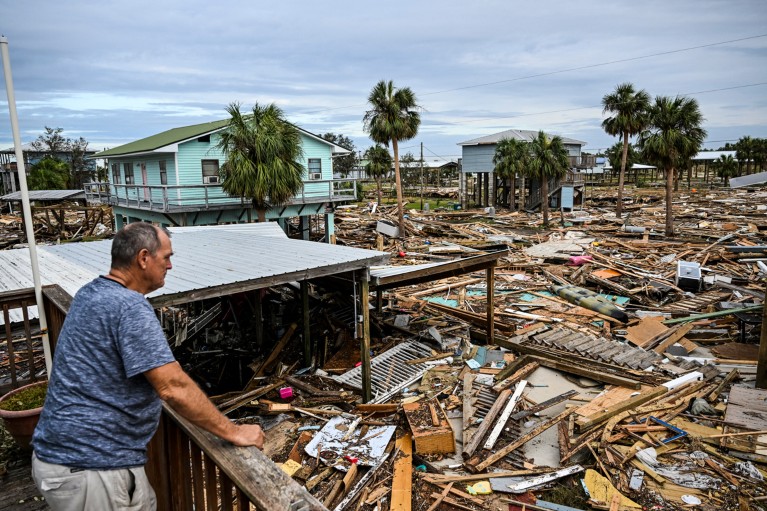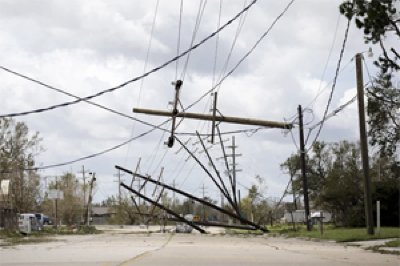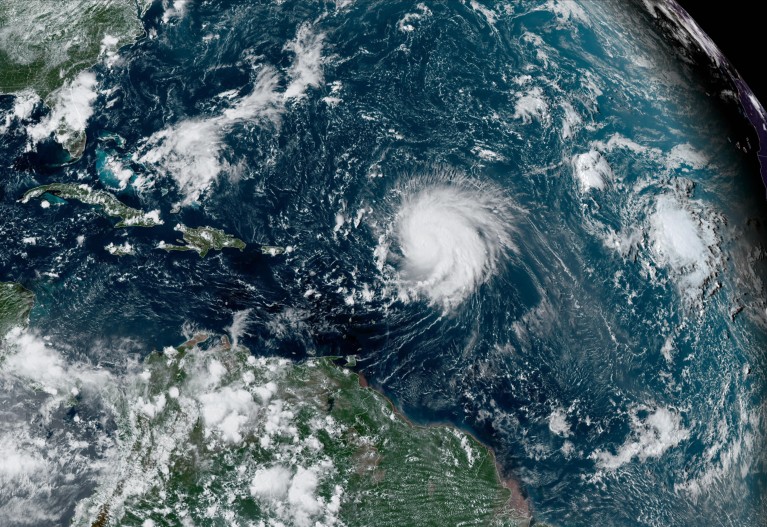
A man surveys the damage done to his house by Hurricane Helene, which left a path of destruction from Florida to Virginia. Credit: Chandan Khanna/AFP/Getty
Climate change sharply intensified almost 85% of hurricanes that hit the North Atlantic between 2019 and 2023, according to a modelling study1. The wind speed of those hurricanes rose by an average of nearly 30 kilometres per hour — enough to have pushed 30 storms up a level on the Saffir-Simpson scale of hurricane intensity.
The study, published today in Environmental Research: Climate, traces the rise in hurricane intensity to the warming of the Atlantic Ocean, which is in turn driven by human-caused climate change. A companion report, based on the methodology in the new paper, suggests that climate change strengthened all 11 hurricanes in the North Atlantic— the Atlantic north of the equator — this year.

Hurricane Ida forces Louisiana researchers to rethink their future
“We, as human beings, have our fingerprints all over these hurricanes,” says Daniel Gilford, the lead author of the study and a climate scientist at Climate Central, a non-profit research organization in Princeton, New Jersey that produced the companion report. “If we can boost up the temperatures of the sea surface, we can also boost up how quickly a hurricane can spin.”
The study adds to a growing body of research showing that global warming amplifies hurricanes. Rising seas caused by global warming are also intensifying hurricanes, research has shown. And the storms are striking earlier in the season and producing greater rainfall than past hurricanes have done.
Devastating consequences
This year’s Atlantic hurricane season has been devastating. For example, Hurricane Helene, which tore through the southeastern United States in August, dropped almost 80 centimetres of rain in some locations. The storm killed more than 200 people and inflicted as much as US$250 billion of damage — a figure that would vault Helene ahead of 2005’s Hurricane Katrina as the most expensive hurricane to slam the United States.

How to recover when a climate disaster destroys your city
In Asheville, North Carolina, the US city hardest-hit by Helene, areas next to the French Broad River were “completely devastated and washed away”, says Carl Schreck, a tropical meteorologist at North Carolina State University in Asheville. The region “experienced more wind damage than I would have expected from a hurricane this far inland,” he says, adding that the wind brought down trees and power lines, cutting off communications to the city for several days. Helene’s winds, which peaked at 225 kilometres per hour, were roughly 26 kilometres per hour higher than they would have been without a warming effect on the Atlantic, according to the Climate Central report.
Flooding knocked out the main water line to the National Centers for Environmental Information, a branch of the National Oceanic and Atmospheric Administration (NOAA) in downtown Asheville that archives global weather and climate data. This shut off cooling for the centre’s supercomputers, Schreck says. “In the days after the storm, they were actually taking a fire truck to one of the local lakes” and pumping out lake water to top up the cooling system. A few computers overheated and will have to be replaced, and the event delayed Climate Central’s report, which relied on data from the centre. But no data were lost, the paper archives remained dry and the centre is back up and running, he says.
Dangerous waters
Hurricanes are fuelled by warm ocean water. In theory, the warmer the water, the greater the hurricane’s intensity, which is measured by its wind speed. Climate change has provided plenty of fuel: sea surface temperatures have increased by approximately 1 °C in the North Atlantic since 1900 owing to climate change.
To uncover the extent to which climate change is to blame for the intensity of recent hurricanes in this region, Gilford and his co-authors simulated how all 49 hurricanes that hit the North Atlantic between 2019 and 2024 would have unfolded if climate change hadn’t warmed the ocean. Then, the scientists compared the wind speeds of the simulated storms with those of the actual storms.

Hurricane Lee intensified into a Category 5 storm in September 2023. Credit: NOAA/Getty
Climate change intensified 30 of the hurricanes so much that they could be classified as one category higher on the Saffir-Simpson scale than they would have been without climate change. Climate change probably boosted five storms — Lorenzo (2019), Ian (2022), Lee (2023), Milton (2024) and Beryl (2024) — over the past five years to Category 5 hurricanes, which NOAA describes as causing “catastrophic damage”.
“The study does a very commendable job of quantifying that change that we’ve seen”, says Ryan Truchelut, the co-founder and chief meteorologist at Weather Tiger, a weather and climate forecasting company in Tallahassee, Florida. He says that the study’s authors used the best available data and appropriate statistical methods to try to determine whether a hurricane was affected by climate change.
Schreck says the study is needed, but that providing a single wind-speed increase for each storm, as the authors did, rather than a range of values with margins for error, is “over-simplified”. The paper’s model does not account for all real-world complexities of ocean conditions and storm behaviour that create uncertainty, he says.
“Climate change is here,” Gilford says. “We need to have more conversations about reducing our greenhouse-gas emissions quickly.”






